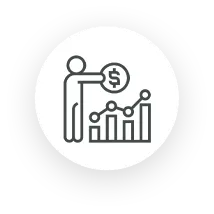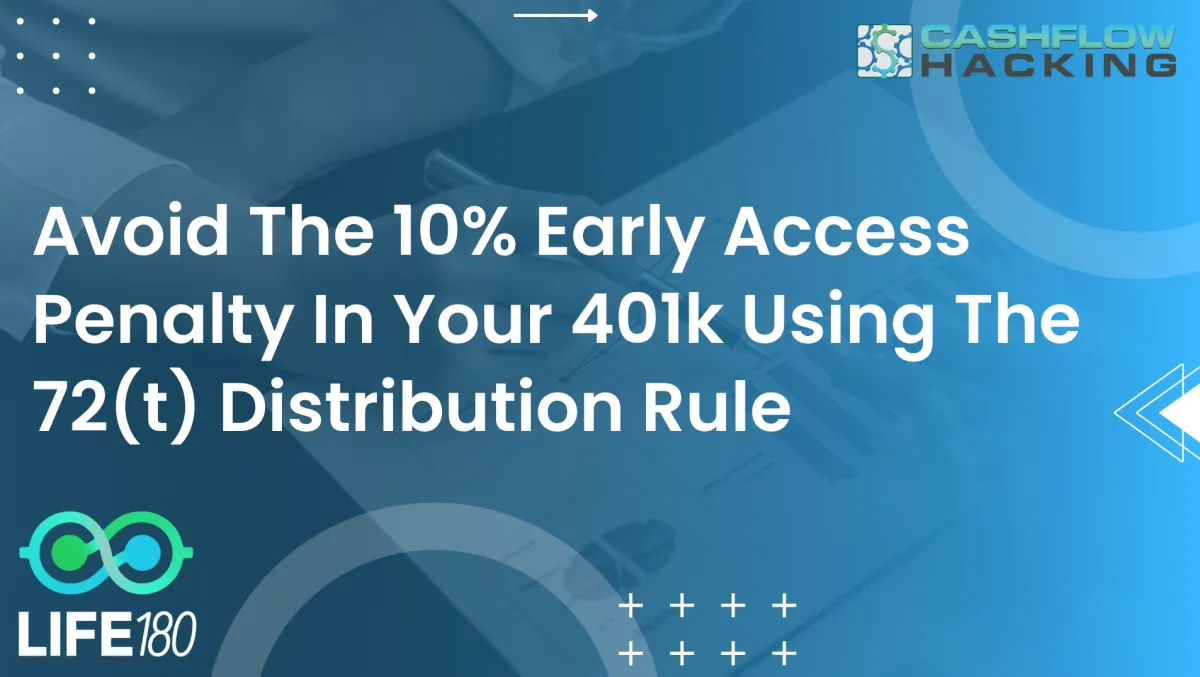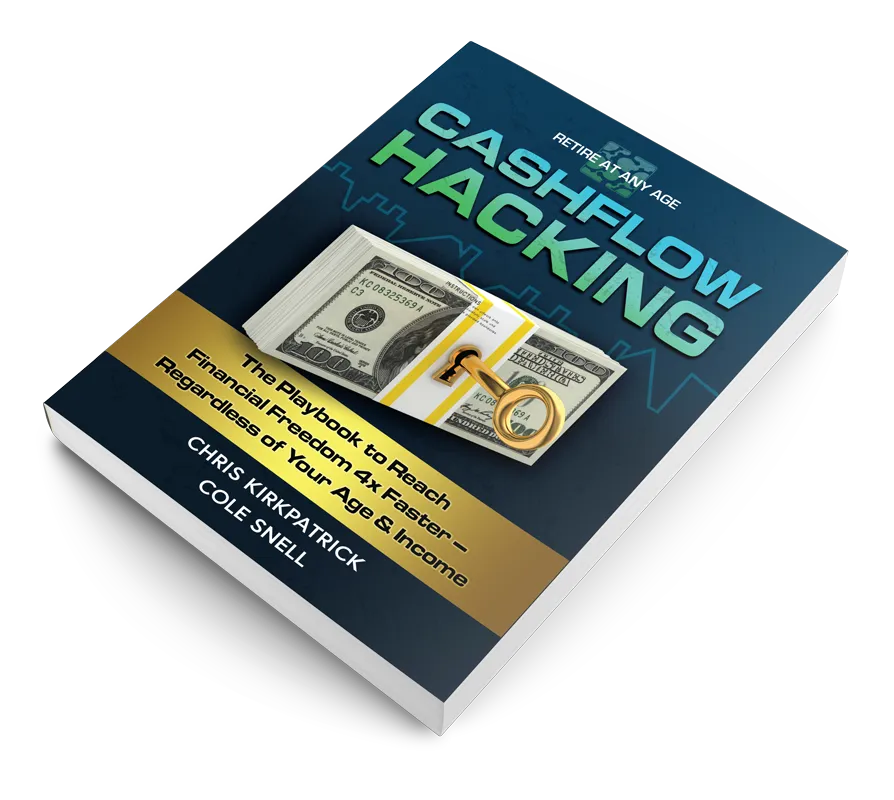
Simplifying Financial Confusion
LEARN CASH FLOW HACKING TO REACH FINANCIAL FREEDOM
Used by 90% of millionaires to reach their financial goals 4x faster

Achieve Financial Freedom Through Cash Flow Hacking

Increase Your Lifestyle While You Build Your Wealth

Position Yourself to Thrive in Market Downturn
YOU SHOULD NOT FEEL OUT OF CONTROL ABOUT YOUR FINANCIAL STRATEGY

Have easy access to your money in case of emergencies and opportunities

Use the investment strategy 90% of millionaires use

You deserve a clear plan to consistently grow your money and avoid market uncertainty

Have a guide and advisor that has your best interest in mind

Do not overpay in taxes

Stop guessing at the best vehicles to protect and grow your money

Mitigate the 10% Early Withdrawal Penalty in Your 401(k) with the Strategic Application of the 72(t) Distribution Rule
This article is a written adaptation of the video content that you can find on the LIFE180 YouTube channel.
¿Did you know that, through a mechanism known as the 72(t) distribution rule, you can access your 401(k) and qualified funds without incurring penalties before reaching the age of 59 1⁄2?
With the current uncertainty surrounding possible potential tax increases due to concerns about the national debt, annual deficits, and unfunded liabilities, it's true that now might be the opportune moment for you to explore the option of using the 72(t) distribution rule. This strategy allows you to take control of your money and explore alternative investment opportunities.
I want to emphasize that the following information should not be considered personal advice. While this concept may be beneficial for some individuals, it can have detrimental effects on others. The primary goal of this article is intended to make you aware of your options and to provide an understanding of the concept as a whole.
Introduction to the 72(t) Distribution Rule: A Strategy to Avoid 10% 401k Penalty
People with qualified accounts seeking to access funds for alternative investment opportunities before reaching the age of 59 1⁄2 are likely familiar with the frustration associated with discovering the imposition of a 10% penalty on accessing their own funds.
It appears somewhat questionable to me that the government encourages placing money into a tax deferred account, only to impose both income taxes upon withdrawal and an additional 10% penalty if accessed before the age of 59 1⁄2. Nevertheless, these are the established regulations.
In essence, if you had $100,000 in a 401(k) and faced a 20% tax plus a 10% early access penalty, you'd end up with approximately $70,000 from a $100,000 account balance. However, it's crucial to grasp that escaping taxes is not an option when investing in a qualified account.
You Don't Get A Tax Deduction With Your 401k
Many believe they receive a tax deduction, but it's a misunderstanding; it's a tax deferral. The key difference lies here. Understand that by placing money in a qualified account like a 401(k), you're not avoiding tax payments; you're merely postponing them. Whether now or in the future, taxes on your earned income are inevitable, there's no way around it.
If you find yourself among the millions with funds in a qualified account and wish to access that money before reaching the age of 59 1/2, there's a method to avoid the penalty, utilizing a 72T distribution.
What Is The 72(t) Distribution Rule?
So the 72T allows you to take what's called Substantially Equal Periodic Payments (SEPP) from your qualified account. These payments are calculated based on your life expectancy, helping you sidestep the 10% premature distribution penalty on the withdrawn amounts. However, specific rules apply.
Initially, the payments must last the longer of either five years or until you reach the age of 59 1⁄2 years old. Let me explain the process. Depending on when you start, the distribution plan varies. If you initiate a 72T distribution at 57 years old, you'll be required to continue taking the SEPP’s until you reach 62. On the other hand, if you commence at 49 years old, you'll need to adhere to the SEPP’s until you're 59 1⁄2. Fortunately, you have the possibility to schedule a clarity call to assist you in determining and visualizing the specific details for your situation. and I've included a link to a Clarity Call below, so check it out if you're interested.
However, there's a crucial point to consider, you don't have the liberty to choose how you receive distributions. Instead, you must calculate them using one of the IRS's approved methods. The Internal Revenue Service (IRS) allows three methods for calculating distributions, and it's essential to understand what these three methods entail.
RMD Method
First is the Required Minimum Distribution amount, commonly known as the RMD method. Many people are familiar with RMDs as they involve mandatory distributions from your qualified account once you reach a specific age.
The simplest method for calculating your SEPP is also the one that yields the lowest payment. In this approach, your current balance is divided by your single life expectancy, or joint life expectancy if your retirement plan includes a survivor component.
With this method, your payment is recalculated annually, taking into account your account balance as of December 31st of the preceding year and your current life expectancy. Despite sounding complex, it becomes straightforward once you dive into the details.
This is the only method that allows for a payment that will change as your account value changes. If your account value goes up in value, your payment, your distribution can go up. If it goes down in value, your distribution will go down. Even though the RMD method provides the lowest payment, it may be the best distribution method if you expect wide fluctuations in the value of your account.
Fixed Amortization Method
In employing the Fixed Amortization Method, the annual distribution amount is calculated by amortizing your account balance over your single life expectancy. This strategic approach involves utilizing either the uniform life expectancy table or the joint life expectancy table, selecting the latter when considering the oldest named beneficiary in the arrangement. This method provides a systematic and structured means of distributing funds, ensuring a steady stream of payments aligned with the projected lifespan, thereby contributing to effective financial planning and management.
Fixed Annuitization Method
This method uses an annuity factor to calculate your SEPP. And the annuitization method is actually probably one of the most complex methods. Now the IRS explains it as taking the taxpayer's account balance divided by an annuity factor equal to the present value of an annuity of $1 per month beginning at the taxpayer's age attained in the first distribution year and continuing for life of the taxpayer.
For example, if the annuity factor for a one dollar per year annuity for an individual who's 50 years old is 19.087 assuming interest rate of 3.8 percent an individual with $100,000 account balance would receive an annual distribution of $5,239. All you have to do there is go $100,000 divided by 19.087, and that equals $5,239.
You don't have to know all of that. You can verify it using the calculator, but just be aware that this calculator is based on the annuity 2003 mortality table for 2021. Starting from 2022, the updated life expectancy and distribution tables, finalized by the IRS in November 2020, have replaced the older annuity factors.
The annuity factor tables, surprisingly, are non-sex-based mortality tables. This is noteworthy because, in the realm of life insurance, mortality tables for women tend to offer more favorable terms compared to those for men.
One-Time Change: Modifying Your 72(t) Distribution Method
So your annuitized SEPP is based on your life expectancy only and not based on the age of your beneficiaries. “In addition, on July 3rd, 2002, the IRS actually ruled that you could change your distribution type one time without a penalty from the annuitized or amortized methods to the RMD distribution method”. www.treasury.gov. Why does this matter?, It would allow account holders the option to move from a fixed payment type to a payment that fluctuates annually with the value of their account.
The primary reason for this exception is to allow individuals who've suffered large losses in their account values the option to reduce your distribution payment to prevent the retirement account from basically imploding and prematurely depleting. You can check more out on this rule if you go to U.S. treasury.gov and look up Revenue Ruling 2002-62 and it'll give you everything you need.
Risks of Using the 72(t) Distribution
The 72T distribution has some risks and I want to talk about a couple of those. So first and foremost, if payments are changed for any reason other than death or disability before the required distribution period ends, the distributions may be subject to a retroactive application of the premature distribution penalty.
So if you screw that up, you still might wind up being responsible to pay that 10% penalty. But to make it worse, not only would you be responsible to pay the 10% early distribution penalty back, but you'd also be required to pay interest for all distributions beginning when you started the SEPP in the first place.
I want to give a friendly reminder here. It's important to remember that while 72T distributions are not subject to the 10% penalty for early withdrawal, all applicable taxes on the distributions must still be paid.
Taking an early distribution from a retirement account is gonna reduce the amount of money that you have available later in your years, you got to be careful about that. Basically what I'm saying is if you're gonna do this, do it as part of a more comprehensive plan that you're gonna execute. Do not do it for lifestyle unless you absolutely need to.
There are risks on both sides of the equation, so the real question is, where do you wanna take these risks?, when it comes to figuring out your account balance for a 72T distribution, there's some things to consider, because your account balance is gonna fluctuate all over the map if it's invested differently. So unfortunately, the IRS has a little wiggle room here because it confuses people, but ultimately what they say is, you need to use your account balance to determine what your step is going to be.
And the IRS rules allow for an account balance to be determined in any reasonable manner based on the facts and circumstances. So if that's not vagueness, I don't know what is now. That can be good and it can be bad. Like we can find some loopholes potentially, but talk to your accountant who will help you through this.
Determining Your 401k Balance for 72(t) Distributions
However, the IRS does offer an example illustrating a reasonable method for determining account balances for the minimum distribution method. It's important to note that this example is not an absolute rule, and its application is not specific to other methods. According to the IRS, this example permits the use of an account balance from any daily value between December 31st of the year preceding the distribution's commencement and the actual date of the first distribution. Subsequently, for all ensuing years, the account balance on December 31st of the prior year can be utilized for the account balance on a date within a reasonable period of the distribution.
Now, your age becomes a crucial factor. The age to consider is your current age, specifically the age you will turn on your birthday, which, for calculation purposes, is considered on August 1st. It's vital to emphasize that your age is a pivotal element in determining the applicable mortality tables. This is a detail that often goes unnoticed.
Equally significant is the age of your beneficiary. If your plan involves a survivor or joint life expectancy component, the same principle holds true for them. The age to consider is the age they will be turning in that particular year.
Choose from 3 Life Expectancy Tables for 72(t)
A lesser-known aspect is the freedom to choose your life expectancy tables. The IRS provides three distinct life expectancy tables that you can opt for when calculating your SEPP using either the fixed amortized or the RMD method.
Once again, I recommend checking out the calculator and running the numbers for yourself. If you need assistance, feel free to reach out to us. I can connect you with my team, a dedicated group of certified financial planners and planning experts who can provide guidance through this process. I understand it's not a straightforward task, but it's crucial to navigate through this process systematically.
If you're seriously contemplating this liquidation, it's essential to proceed with care. I strongly encourage you to consider a consultation. If you're unsure about whether this is the right move for you and would like personalized advice, don't hesitate to reach out. I can arrange a call with our Certified Financial Planner who can guide you through the potential options that might best suit your situation.
I strongly advise against attempting this process on your own or seeking guidance from someone who isn't licensed for such matters. If you choose to schedule one of these calls, please explicitly mention your interest in a 72T distribution. This way, I can ensure that I connect you with the right licensed professional on our team, as not everyone is authorized to provide guidance on this particular aspect.
I trust you found value in this article. If you did, please consider sharing it to help spread awareness of the various options available for managing your finances. Until next time, have a blessed and inspirational day.
HOW TO START TAKING CONTROL OF YOUR FINANCES BY MAXIMIZING YOUR CASH FLOW AND PROTECTING YOUR ASSETS

1. Schedule Your Free Clarity Call

2. Create a Free Customized Plan

3. Get Guide to Financial Success
GET YOUR FREE COPY TO STOP USING OUTDATED RETIREMENT STRATEGIES
Cash Flow Hacking teaches you to:
Protect Your Investments
Thrive in bad markets
Reach financial freedom faster

ARE YOU LOOKING FOR:

Cash Flow Hacking teaches you to:
Security to protect your money
Increased cash flow and lifestyle
Inflation protection
Financial certainty in all economic environments
A reduction in taxes
Safe and fast access to your money with no penalties
WHO IS THIS PROGRAM FOR?

People looking for an alternative
Are you looking for alternatives to Wall Street’s “buy and hold” strategy that takes 40 years with uncertain results? Our Cash Flow Hacking strategies provide you the building blocks to get started on the right foot

Passionate Entrepreneurs
Are you looking for a financial strategy that will take your best assets (you and your businesses) and multiply their potential? Our Cash Flow hacking strategies will teach you how to invest for the future without sacrificing building your business

Real Estate
Investors
Are you a real estate investor who is burned out from being a landlord or playing the fix-and-flip game? Our Cash Flow Hacking strategies will provide you with the system to create predictable wealth AND give you the freedom you are looking for.
YOU DESERVE PEACE OF MIND AND A PLAN THAT WILL PROTECT YOUR FAMILY AND GROW YOUR WEALTH
Today you need to be more savvy than ever if you try to go at it alone.
Losing money to inflation, taxes, and just poor investment strategies is leaving you frustrated, feeling out of control and not knowing where to turn. To add to the problem, the market is flooded with advisors who have outdated advice that does not place your best interests first, but instead focuses on charging you a fee that creates guaranteed cash flow for them.
NOT YOU
We believe this is wrong and that your security and best interests should be placed first. We believe you should be in a position where you control your money, your money doesn't control you. We understand because we talk with hardworking people everyday that are losing money in the markets based on old information and feel like they are guessing at the best course of action.
We created the Cash Flow Hacking plan to help you have security and control of your money to take advantage of life's opportunities because you deserve peace of mind with your wealth. The old way of planning for retirement of… Go to school Get a job & save as much as you can in your 401k and mutual funds...is broken.
You have been lied to. Think about it, where else in life does someone tell you that the most certain way to achieve your desired result is to take on more risk? The math just doesn't work, and the results are showing in our country and world. Did you know that 90% of millionaires in the United States have 1 asset in common?
Hint: it's not stocks or mutual funds (and no...it's not crypto) How much sense does it make for you to work hard, save money, reduce your current lifestyle (because that's what you are doing when you save for the future - taking money you could use on lifestyle today and delaying gratification to a future unknown time), and hope that whatever you are doing will work three to four decades from now? If you're thinking, "not much sense at all…", you are in the right place.
With over 50 years of experience on our team, we have worked with thousands of individuals and families to achieve financial freedom faster and with more predictability by helping them invest for Cash Flow.
How does the Cash Flow Hacking Plan work? 1. Take the Cash Flow Hacking Challenge 2. Complete the LIFE180 X-Ray and determine what your Freedom Number is 3. Work with a Cash Flow Hacking expert to provide you a customized plan
The customized Cash Flow Hacking plan will give you clarity on where you are now, where you want to go (and in what time frame), and what you need to do to get there predictably.
We value and commit to you: We believe you deserve the best financial education and guidance We believe financial decisions should not be rushed but be well thought out with a plan We believe you should be in control of your money We believe we earn your trust through time, education, and proper due diligence Without a proper plan and guidance, your money can be lost to taxes, inflation, and bad investments You deserve more with the most up-to-date strategies to mitigate your risk, control your money, and earn stable returns regardless of the market Schedule a call here to attain your LIFE180 Financial X-Ray now or get started with the Cash Flow Hacking Challenge for free.
I am interested in...